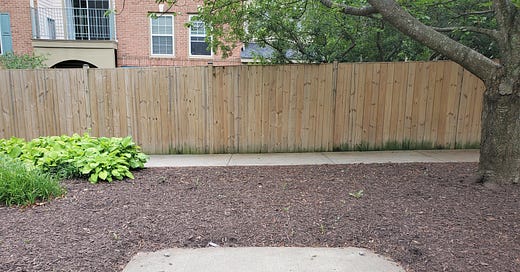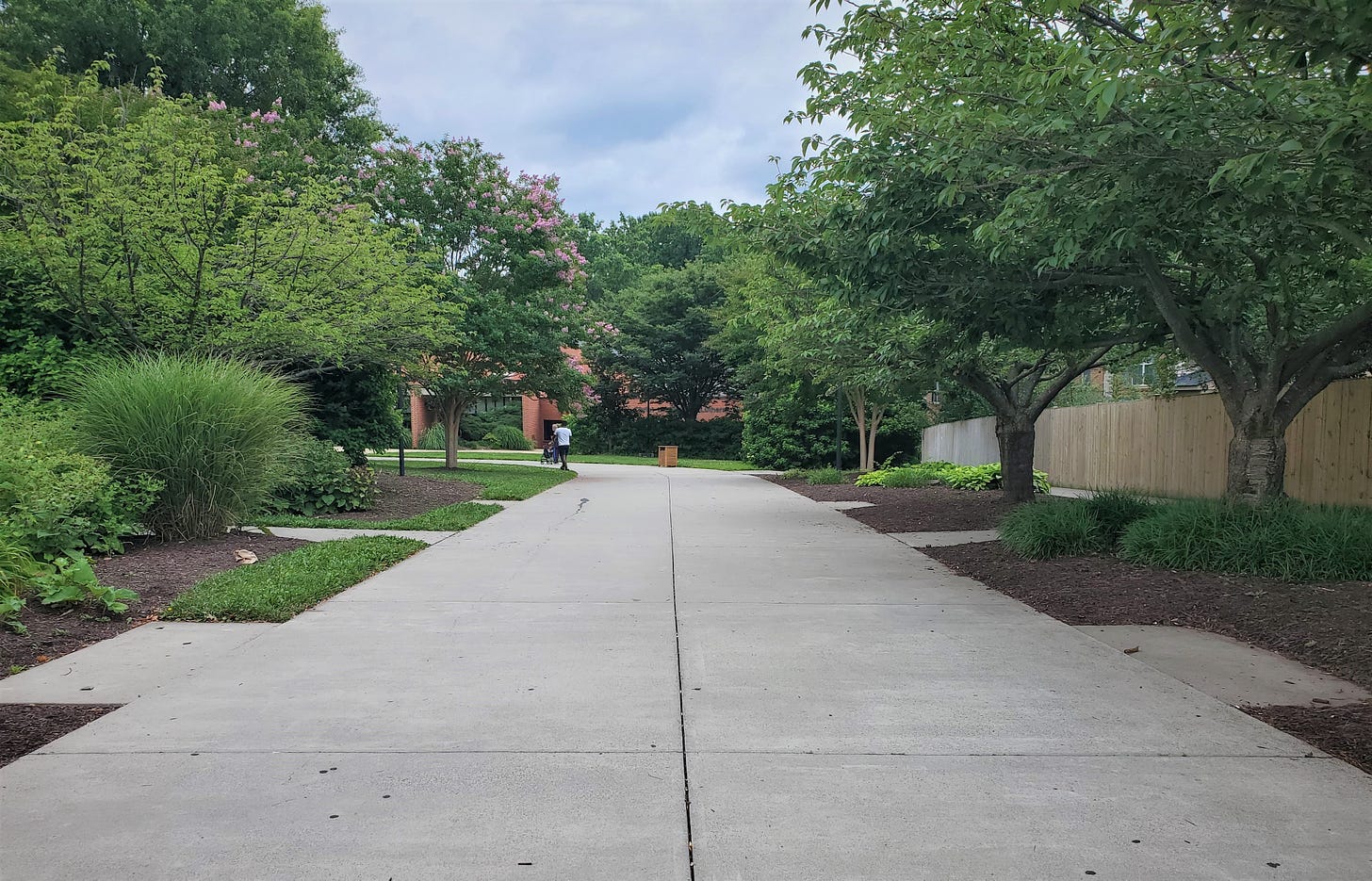I’ve been mulling over this piece for awhile, and honestly was hesitant to write it, because, like talking about urban crime, it can open up a lot of cans of worms. But it’s something you have to think about if you write or think about urban design, public space, and the public realm.
Not far from our home is the Hunter’s Woods Village Center, one of Reston, Virginia’s original village centers (though very little of its original design is still intact.) Reston is near the western edge of Fairfax County, and it’s very suburban, but the village centers were supposed to be sort of town squares; they included churches, libraries, and public art, as well as neighborhood retail. Reston was part of a movement called “New Towns,” kind of a proto-New Urbanism. Read its history here.
Anyway, there’s a Safeway here, a (recently closed) drug store, a bunch of smaller stores and restaurants, a church, and a community center. There’s a high-rise building for seniors behind the community center, and some townhomes right up against the sidewalk leading to the Safeway. There’s a public plaza space where there used to be a few benches.
Used to be.
Here’s a view of part of the public plaza; the benches were where the concrete juts into the grass.
And a closeup:
The benches were most frequently used by young Hispanic men. Mostly they’d sit there and shoot the breeze, sometimes into the night, 10 or 11pm. Occasionally they’d get loud. Sometimes they would drink beer. I saw comments on Nextdoor (I know, not necessarily a reliable source) that occasionally women walking by the benches were catcalled.
None of this bothered me, but it must have bothered some people, because one day, the benches were gone. (Around the same time, a tall wooden fence was also put up to separate the front of the townhome properties from the sidewalk.)
Misanthropic NIMBYs had taken away a public amenity to stick it to non-white people they didn’t like!
However that’s probably too simple, isn’t it? I was chatting on Twitter with a young Asian-American woman, about crime in the subway. Both of us are urbanists, both comfortable riding the D.C. Metro. But I had said something to the effect of old Boomers being afraid of subway crime, and she countered that she also had that fear in the back of her head—given, for example, that New York’s rare but horrifying subway pushing incidents have often involved Asian female victims.
Sometimes you’ll see comments like, “Americans would rather get rid of all public services than allow a homeless person to access them.” You see this, for example, with train stations that have no seating, or places where bathrooms in stores are almost always closed. Others will counter that you can’t just absorb the infinite expense of maintaining these things when people consistently misuse/damage/vandalize them. I think there’s probably some truth in both of these takes. And I think you can recognize that and still be compassionate. Taking away things that desperate people need doesn’t make desperate people go away. Making something invisible isn’t the same as fixing a problem.
Now I mentioned crime, but of course, the guys sitting on the benches and occasionally being a little rowdy were not committing any crimes, nor were they really even creating public disorder. They were doing, I suspect, something perfectly normal and deeply human. The same exact behavior in a bar or at a backyard gathering, for example, is perfectly acceptable (minus hopefully the catcalling.) Or really, anywhere that American suburbanites think of as a social space.
But we don’t generally think of strip malls as social spaces, even if there’s a suggestion of a public plaza and a few benches.
But what, then, are the benches for, exactly, if you’re not actually supposed to sit there and chat with friends? Are they just there to look at as you pack your groceries into the car, and think to yourself how nice it would be to sit there one day and chat with friends? What kind of sense does it make to take away a public amenity precisely because someone is actually using it?
Look, I’m not being blasé about crime and public order, and frankly some urbanists are. But again, that wasn’t the problem here. The problem was, maybe, racism. I think it was probably also a culture clash, and a clash of unstated norms about how space is to be used.
Something I wrote in Strong Towns last year is relevant here, I think:
It’s sometimes suggested that Latino immigrants tend to treat American strip plazas like Mexican or Central American town squares; places to hang out or engage in small-scale commerce; spaces to be. By contrast, native-born Americans and particularly white suburbanites tend to regard strip plazas as places to go for specific, narrow reasons, and then leave. I’m sure this oversimplifies things, but it seems to hold some explanatory power.
That link, which makes the claim about how Latin Americans use public space, was in the Washington Post. I’ve heard that supposition elsewhere too.
Also:
There’s a tendency to view this kind of informal reuse of once-pristine suburban landscapes as sort of akin to “downcycling,” a term that denotes the reuse of something in an inferior manner to its original use. It codes as decline, poverty, disinvestment. It suggests crime. Or maybe just a little unchosen and occasionally fraught human interaction, like busking or begging. Or unlicensed food carts.
We’ve come to have a low tolerance for chaos and disorder. We expect things to be neat, organized, clean, frictionless. This expectation is ironic, because we glorify our country’s rough-and-tumble entrepreneurial history, yet we often look down on people who embody it today, and on the commercial landscapes that result.
Here, I was writing about run-down strip malls that have received a second life as bustling quasi-public spaces largely patronized by immigrants. This is pretty common in more working-class pockets of the D.C. region and, I gather, in other metro areas with large populations of immigrants.
But a similar point holds in regard to public behavior. One of the things that has begun to click for me about suburban land use, with its stark separation of uses, is that it artificially renders perfectly natural human behavior kind of suspicious. What we call “loitering” is often what we would call in another context “hanging out,” but again, strip malls are not for hanging out. Why? Why ever would you strictly separate socializing from commerce? Isn’t that kind of bizarre?
In a previous post here, I wrote:
We’ve internalized the separation-of-uses ethic of zoning, and come to view it as a kind of moral prescription. We’re well past moving slaughterhouses and factories out of residential neighborhoods. Too many people think that existing outside of a car, and resisting the single-use nature of American commercial spaces, is somehow vaguely suspect.
I think that explains a lot of this sort of conflict. I do think racism and classism also play a part in these things. And I also think there’s such a thing as a proper way to behave in public. But how we draw those lines is subjective and contingent.
What do you think of this? It’s tough subjects like this where I really value your comments, thoughts, and experiences!
Related Reading:
Thanks for reading! Please consider upgrading to a paid subscription to help support this newsletter. You’ll get a weekend subscribers-only post, plus full access to the archive of over 300 posts and growing—more than one full year! And you’ll help ensure more material like this!






This was thought provoking, thank you.
I share your concerns about the “real” reason these benches were removed; bias, conscious or unconscious. And I’d also point out that the way they were arranged in the first place was pretty lousy and may have also been intended to limit the “troublesome“ behaviors you identify.
- they’re spread too far for people on different benches to converse naturally, implicitly limiting group to the 2-3 people who can fit on a single bench (3 being extra uncomfortable in most cases.)
- if folks on benches opposite each other did raise their voices to chat, then people walking down the walkway have to pass through their loud conversation. Awkward.
- even if there’s not a 20-Ft conversation being lobbed across the path passersby have to cross the forward gaze of anyone sitting on the benches. Natural human curiosity means that gaze is usually going to follow them a bit, which feels a lot like being stared at and judged - by people either sitting in silence (because there’s no one to talk to) or talking with another “judge”. It’s a psychological gauntlet to walk past multiple benches arrayed like viewing stands on a parade.
- the benches are evenly spaced, so there’s no “good spot” to sit. Universal Space designed for automaton citizens, subtly undermining the unique humanity of the real ones.
It speaks well of the Latin community that they have the skills to socialize in a public space designed to frustrate socializing. Perhaps that’s another reason it seems so strange, so “improper” to socialize on a bench, or to “loiter” in a “park.”